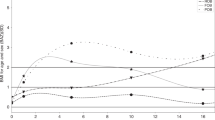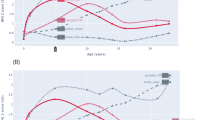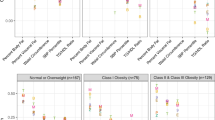Abstract
Background/Objectives:
Our aim was to identify trajectories of total and central adiposity from 13 to 21 years, and to investigate how adiposity changes at different phases of adolescence relate to adulthood cardiovascular risk factors.
Subjects/Methods:
This study included participants from a population-based cohort (EPITeen), Portugal. Body mass index (BMI) and waist circumference (WC) were measured at 13, 17 and 21 years, and sex- and age-specific z-scores were calculated. Adiposity trajectories were identified using mixture growth models (BMI, n=2901; WC, n=2898). Cardiovascular risk factors were evaluated at 21 years (n=1763): systolic (SBP) and diastolic blood pressure (DBP), insulin resistance (HOMA-IR), triglycerides and cholesterol. Association of trajectory, and changes in adiposity z-scores with each cardiovascular risk factor was estimated by linear regression models.
Results:
‘Normal’, ‘high, declining’ and ‘high, increasing’ trajectories were identified in both sexes. ‘High, increasing’ BMI trajectory was associated with less favorable cardiovascular risk profile at 21 years in both sexes, whereas ‘high, declining’ presented a more favorable profile, similar to ‘normal’ trajectory in females. In addition, BMI increases between 13–17 years and 17–21 years were associated with increases in systolic and diastolic blood pressure, and insulin resistance, but more strongly for the later period. For every standard deviation (s.d.) increase in BMI between 17–21 years, mean SBP increased by 1.99 mmHg (95% confidence interval (CI): 1.01; 2.97) for females and 3.83 mmHg (2.67; 4.98) for males; the respective increase was 1.56 mmHg (0.72; 2.40) and 2.80 mmHg (1.97; 3.64) for DBP and 0.27 (0.21; 0.32) and 0.30 (0.24; 0.36) for HOMA-IR (log-transformed). Similar results were found for WC.
Conclusions:
Increases in adiposity, particularly from late adolescence-to-young adulthood, were associated with unfavorable cardiovascular profile in early adulthood. A benefit on the cardiovascular risk profile for participants in the declining adiposity trajectory was observed.
This is a preview of subscription content, access via your institution
Access options
Subscribe to this journal
Receive 12 print issues and online access
$259.00 per year
only $21.58 per issue
Buy this article
- Purchase on Springer Link
- Instant access to full article PDF
Prices may be subject to local taxes which are calculated during checkout


Similar content being viewed by others
References
Ng M, Fleming T, Robinson M, Thomson B, Graetz N, Margono C et al. Global, regional, and national prevalence of overweight and obesity in children and adults during 1980–2013: a systematic analysis for the Global Burden of Disease Study 2013. Lancet 2014; 384: 766–781.
McCrindle BW . Cardiovascular consequences of childhood obesity. Can J Cardiol 2015; 31: 124–130.
Regnault N, Gillman MW . Importance of characterizing growth trajectories. Ann Nutr Metab 2014; 65: 110–113.
Singh AS, Mulder C, Twisk JW, van Mechelen W, Chinapaw MJ . Tracking of childhood overweight into adulthood: a systematic review of the literature. Obes Rev 2008; 9: 474–488.
Attard SM, Herring AH, Howard AG, Gordon-Larsen P . Longitudinal trajectories of BMI and cardiovascular disease risk: the national longitudinal study of adolescent health. Obesity 2013; 21: 2180–2188.
Haga C, Kondo N, Suzuki K, Sato M, Ando D, Yokomichi H et al. Developmental trajectories of body mass index among Japanese children and impact of maternal factors during pregnancy. PLoS One 2012; 7: e51896.
Huang RC, de Klerk NH, Smith A, Kendall GE, Landau LI, Mori TA et al. Lifecourse childhood adiposity trajectories associated with adolescent insulin resistance. Diabetes Care 2011; 34: 1019–1025.
Boyer BP, Nelson JA, Holub SC . Childhood body mass index trajectories predicting cardiovascular risk in adolescence. J Adolesc Health 2015; 56: 599–605.
Ventura AK, Loken E, Birch LL . Developmental trajectories of girls' BMI across childhood and adolescence. Obesity 2009; 17: 2067–2074.
von Bonsdorff MB, Tormakangas T, Rantanen T, Salonen MK, Osmond C, Kajantie E et al. Early life body mass trajectories and mortality in older age: findings from the Helsinki Birth Cohort Study. Ann Med 2015; 47: 34–39.
Ziyab AH, Karmaus W, Kurukulaaratchy RJ, Zhang H, Arshad SH . Developmental trajectories of body mass index from infancy to 18 years of age: prenatal determinants and health consequences. J Epidemiol Community Health 2014; 68: 934–941.
Howe LD, Tilling K, Benfield L, Logue J, Sattar N, Ness AR et al. Changes in ponderal index and body mass index across childhood and their associations with fat mass and cardiovascular risk factors at age 15. PLoS One 2010; 5: e15186.
Gordon-Larsen P, Adair LS, Nelson MC, Popkin BM . Five-year obesity incidence in the transition period between adolescence and adulthood: the National Longitudinal Study of Adolescent Health. Am J Clin Nutr 2004; 80: 569–575.
Nelson MC, Story M, Larson NI, Neumark-Sztainer D, Lytle LA . Emerging adulthood and college-aged youth: an overlooked age for weight-related behavior change. Obesity 2008; 16: 2205–2211.
Dietz WH . Critical periods in childhood for the development of obesity. Am J Clin Nutr 1994; 59: 955–959.
Hardy R, Wadsworth ME, Langenberg C, Kuh D . Birthweight, childhood growth, and blood pressure at 43 years in a British birth cohort. Int J Epidemiol 2004; 33: 121–129.
Law CM, Shiell AW, Newsome CA, Syddall HE, Shinebourne EA, Fayers PM et al. Fetal, infant, and childhood growth and adult blood pressure: a longitudinal study from birth to 22 years of age. Circulation 2002; 105: 1088–1092.
Lee JS, Kawakubo K, Kashihara H, Mori K . Effect of long-term body weight change on the incidence of hypertension in Japanese men and women. Int J Obes Relat Metab Disord 2004; 28: 391–395.
Johnson W, Kuh D, Tikhonoff V, Charakida M, Woodside J, Whincup P et al. Body mass index and height from infancy to adulthood and carotid intima-media thickness at 60 to 64 years in the 1946 British Birth Cohort Study. Arterioscler Thromb Vasc Biol 2014; 34: 654–660.
Bhargava SK, Sachdev HS, Fall CH, Osmond C, Lakshmy R, Barker DJ et al. Relation of serial changes in childhood body-mass index to impaired glucose tolerance in young adulthood. N Engl J Med 2004; 350: 865–875.
Fabricius-Bjerre S, Jensen RB, Faerch K, Larsen T, Molgaard C, Michaelsen KF et al. Impact of birth weight and early infant weight gain on insulin resistance and associated cardiovascular risk factors in adolescence. PLoS One 2011; 6: e20595.
Black E, Holst C, Astrup A, Toubro S, Echwald S, Pedersen O et al. Long-term influences of body-weight changes, independent of the attained weight, on risk of impaired glucose tolerance and type 2 diabetes. Diabet Med 2005; 22: 1199–1205.
Gamborg M, Andersen PK, Baker JL, Budtz-Jorgensen E, Jorgensen T, Jensen G et al. Life course path analysis of birth weight, childhood growth, and adult systolic blood pressure. Am J Epidemiol 2009; 169: 1167–1178.
Power C, Thomas C . Changes in BMI, duration of overweight and obesity, and glucose metabolism: 45 years of follow-up of a birth cohort. Diabetes Care 2011; 34: 1986–1991.
Ramos E, Barros H . Family and school determinants of overweight in 13-year-old Portuguese adolescents. Acta Paediatr 2007; 96: 281–286.
Friedewald WT, Levy RI, Fredrickson DS . Estimation of the concentration of low-density lipoprotein cholesterol in plasma, without use of the preparative ultracentrifuge. Clin Chem 1972; 18: 499–502.
Matthews DR, Hosker JP, Rudenski AS, Naylor BA, Treacher DF, Turner RC . Homeostasis model assessment: insulin resistance and beta-cell function from fasting plasma glucose and insulin concentrations in man. Diabetologia 1985; 28: 412–419.
Weber MA, Schiffrin EL, White WB, Mann S, Lindholm LH, Kenerson JG et al. Clinical practice guidelines for the management of hypertension in the community a statement by the American Society of Hypertension and the International Society of Hypertension. J Hypertens 2014; 32: 3–15.
Jones BL, Nagin DS, Roeder KA . SAS procedure based on mixture models for estimating developmental trajectories. Sociol Methods Res 2001; 29: 374–393.
Jun HJ, Corliss HL, Boynton-Jarrett R, Spiegelman D, Austin SB, Wright RJ . Growing up in a domestic violence environment: relationship with developmental trajectories of body mass index during adolescence into young adulthood. J Epidemiol Community Health 2012; 66: 629–635.
Nonnemaker JM, Morgan-Lopez AA, Pais JM, Finkelstein EA . Youth BMI trajectories: evidence from the NLSY97. Obesity (Silver Spring) 2009; 17: 1274–1280.
Tu A . Developmental growth patterns of canadian children and the effect of the neighbourhood environment on growth. PhD thesis,The University of British Columbia: Vancouver, WA, USA, 2014.
Weiss UK, Body Mass, Index Trajectories . And health-risk behaviors: transition to adulthood. PhD thesis. The Florida State University: Tallahassee, FL, USA, 2012.
Huxley R, Mendis S, Zheleznyakov E, Reddy S, Chan J . Body mass index, waist circumference and waist:hip ratio as predictors of cardiovascular risk-a review of the literature. Eur J Clin Nutr 2010; 64: 16–22.
Barreira TV, Staiano AE, Harrington DM, Heymsfield SB, Smith SR, Bouchard C et al. Anthropometric correlates of total body fat, abdominal adiposity, and cardiovascular disease risk factors in a biracial sample of men and women. Mayo Clin Proc 2012; 87: 452–460.
Bosy-Westphal A, Geisler C, Onur S, Korth O, Selberg O, Schrezenmeir J et al. Value of body fat mass vs anthropometric obesity indices in the assessment of metabolic risk factors. Int J Obes 2006; 30: 475–483.
Berenson GS, Srinivasan SR, Cresanta JL, Foster TA, Webber LS . Dynamic changes of serum lipoproteins in children during adolescence and sexual maturation. Am J Epidemiol 1981; 113: 157–170.
Pinhas-Hamiel O, Lerner-Geva L, Copperman NM, Jacobson MS . Lipid and insulin levels in obese children: changes with age and puberty. Obesity 2007; 15: 2825–2831.
Li L, Law C, Power C . Body mass index throughout the life-course and blood pressure in mid-adult life: a birth cohort study. J Hypertens 2007; 25: 1215–1223.
Acknowledgements
This study was supported by national funding from the Portuguese Foundation for Science and Technology—FCT (Portuguese Ministry of Education and Science) within the Epidemiology Research Unit—Institute of Public Health, University of Porto (UID/DTP/047507/2013). The Population, Policy and Practice Programme was formed in 2014, incorporating the activities of the Centre for Paediatric Epidemiology and Biostatistics, which was supported in part by the Medical Research Council in its capacity as the MRC Centre of Epidemiology for Child Health (award G0400546). Research at the GOSH/UCL Institute of Child Health is supported in part by the Department of Health’s NIHR Biomedical Research Centres. An individual grant to JA (SFRH/BD/78153/2011) by the Portuguese Foundation for Science and Technology—FCT is gratefully acknowledged.
Author information
Authors and Affiliations
Corresponding author
Ethics declarations
Competing interests
The authors declare no conflict of interest.
Additional information
Supplementary Information accompanies this paper on International Journal of Obesity website
Rights and permissions
About this article
Cite this article
Araújo, J., Barros, H., Ramos, E. et al. Trajectories of total and central adiposity throughout adolescence and cardiometabolic factors in early adulthood. Int J Obes 40, 1899–1905 (2016). https://doi.org/10.1038/ijo.2016.170
Received:
Revised:
Accepted:
Published:
Issue Date:
DOI: https://doi.org/10.1038/ijo.2016.170
This article is cited by
-
A three-arm randomized controlled trial using ecological momentary intervention, community health workers, and video feedback at family meals to improve child cardiovascular health: the Family Matters study design
BMC Public Health (2023)
-
Trajectories of waist circumference during young adulthood and incident hypertension: the China Health and Nutrition Survey
Journal of Human Hypertension (2022)
-
Socioeconomic circumstances and lung function growth from early adolescence to early adulthood
Pediatric Research (2021)
-
Do body mass index and waist-to-height ratio over the preceding decade predict retinal microvasculature in 11–12 year olds and midlife adults?
International Journal of Obesity (2020)



